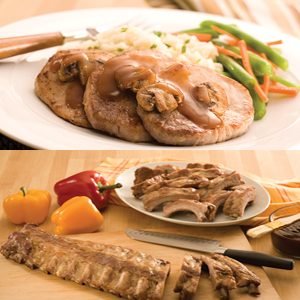Change could be coming for meat and poultry processors who use injections or marinades with their products — some of it due to regulations and some due to innovation, particularly for natural, grass-fed and low-sodium products.

|
| Photos courtesy of Seaboard Foods |
This month, the Food Safety and Inspection Service (FSIS) will be closing its second comment period on its proposed rule, “Common or Usual Name for Raw Meat and Poultry Products Containing Added Solutions.”
Last summer, the agency proposed that a common or usual name be used for raw meat and poultry products that do not meet the standard of identity regulations and also to which solutions have been added. In addition, the FSIS suggested that these products provide an accurate description of the raw meat or poultry component, the percentage of added solution and the ingredients or multi-ingredient components in the solution by weight.
As an example, the agency compared a single-ingredient piece of chicken to one with added teriyaki marinade. Both can now be labeled as “chicken,” although one is 100 percent chicken and the other is 60 percent chicken and 40 percent solution. The FSIS’s solution would be to label the teriyaki chicken as “chicken — 40 percent added solution of water and teriyaki sauce.”
Accordingly, it was also proposed that the product’s name should appear in a single font size, color and style of print on a single-color contrasting background. And lastly, the FSIS suggested that “ready-to-cook products to which solutions are added” should have their standard of identity regulation removed.
Cleaning up labels
Indeed, cleaner labels (of natural products) and reduced-sodium products are still top of mind in the meat and poultry industry. Consumer demand for natural products has subsided somewhat during the ongoing economic slump due to their higher prices, but processors are still experimenting with new compound formulas to create a more pleasing taste with less ingredients.
Generally, when making natural products by injection, some type of starch would need to be used in place of phosphates, says Lynn Knipe, Ph.D., extension processed meats specialist and associate professor in Food Science and Technology and Animal Sciences at Ohio State University. Potato starch is perhaps the most commonly used ingredient for this purpose.
“Some people have also been successful in holding moisture in products using carrageenan, carrot fiber and dehydrated pork stock,” says Knipe. “If it is to have a cured color, such as ham or corned beef, cultured celery powder is commonly used. Whereas the package may say that there is no sodium nitrite added, the cured color is formed from the nitrite in the celery powder.”
In addition, lactates and diacetates, which are typically added as anti-Listeria ingredients, would need to be replaced by natural ingredients, such as vinegar and lemon juice, for which commercial mixtures are available, he says.
In 2010, professors from Auburn University’s Department of Animal Sciences and Poultry Sciences set out to determine if they could develop a grass-fed beef product that had a longer shelf life, decreased oxidation and lessen the negative flavor components associated with grass-fed beef, which they believe they accomplished, says Chris Kerth, Ph.D., associate professor of meat science and muscle biology in the Department of Animal Science, Texas A&M University, based in College Station, Texas.
“The current technology associated with natural ingredients does a good job replacing the traditional cured parts, but a lot of variables still remain with the tenderness and flavor of grass-fed beef,” says Kerth, an author of the McMurtrie, K.E., et al.,November 2011 report titled “Marination with natural curing ingredients, storage time, and serving temperature effects on the sensory characteristics of forage-finished or commercially-sourced beef roasts” and published in MeatScience.
To that end, the researchers took pre-portioned round roasts from forage-finished cattle and commercially sourced beef and assigned them a treatment from the control, injected-no cure or injected-cured groups, a serving temperature and storage treatment, says Kerth.
Grass-fed beef that had brines injected into them had a significantly improved tenderness, juiciness and decreased grassy flavor, he says, and could retain a large amount of injections. In addition, forage-finished beef from inside round roasts also yielded better quality and shelf life after being injected with brines — with or without natural curing ingredients.
“There is an ongoing need for education for processors because more and more new ingredients and technologies exist to create new and existing products from alternative sources of active ingredients and binders — such as thermally reduced gels, cold gels and reversible gels — that open up the door to create products in processed areas,” says Kerth. “The biggest hurdle is keeping up with the technology out there to create products consumers are interested in.”
Cutting back on salt
Processors interest in reduced sodium products can be traced back to April 2010 when the Institute of Medicine made a statement that U.S. citizens needed to reduce their sodium intake.
“As a result of this, the larger food companies have made commitments to consumers that they will reduce the sodium content of their products by 25 percent over the next five years,” says Knipe. “Since then, a study from Exeter University in England claimed that there has not been enough data collected yet to conclude that reducing sodium content offered any health benefits.”
In April of 2011, Seaboard Foods announced it had lowered the sodium in its PrairieFresh Prime fresh pork products — by 26 percent in a 4-ounce serving of unseasoned PrairieFresh pork loin, for instance — while maintaining its regular flavor.
“As a company, we’re constantly monitoring culinary trends and recognized that lower sodium was more than a fad and long-term consumer expectation,” says David Eaheart, APR, director of marketing, Seaboard Farms, based in Shawnee Mission, Kan. “Even though the sodium content wasn’t extremely high in the original PrairieFresh Prime products, we made a commitment to lower sodium content in our products whenever possible without sacrificing quality.”
In fact, it is the water-holding capacity of salt that causes meat to be juicier, giving consumers the perception of increased tenderness.
To make reduced-odium products, many ingredients exist that claim to enhance or mimic the flavor of salt or allow for the reduction of sodium chloride for flavor, says Knipe. However, as consumers continue to ask for cleaner labels, they would not necessarily be happy to see these ingredients on labels.
“In my opinion, processors need to gradually reduce the sodium content of their products, so that consumers don’t notice big changes in flavor,” he says. “This gradual reduction also allows processors to adjust to the other changes that result from salt reduction: product bind [yield and texture] and product safety.”
So, to provide less sodium and a cleaner label, processors are compensating for the reduced bind resulting from lower salt levels by using pre-rigor meat, maceration, or vacuum tumbling of the salt that is used with the lean meat at cold temperatures, says Knipe. These methods allow for maximizing the extraction and binding of the protein in the meat.
In addition, he says that adding phosphates would help with the bind issue, while adding sodium phosphates will not significantly raise the sodium level.
“However, if there was a desire to remove the sodium phosphate name from the label, potassium phosphates are also available, as well as the potato starch and other water-inding ingredients mentioned earlier,” says Knipe.
Researchers continue to experiment with using enzymes as part of marinades to soften beef connective tissue, in order to reduce sodium levels, but so far haven’t found much success.
In fact, in April of 2010, professors Zeb Pietrasik and Phyllis J. Shand from the University of Saskatchewan published a paper on how “Bovine biceps femoris is resistant to tenderization by lower-salt enhancement or enzyme addition,” in the Canadian Journal of Animal Science.
As the paper’s title states, the enzymes tested were unable to improve sensory tenderness or reduce the amount of detectable connective tissue in the biceps femoris muscle.
“We were looking at enzymes as a way to tenderize the tougher cuts of meat, so processors could provide value-added but economical products,” says Shand.
Their research showed that marinades with brines that contain salt and phosphate improved the juiciness and lessened the myofibrillar toughening to overall shear force, the paper noted. But salt/phosphate injection does not appear to affect the palatability of high connective tissue muscle, especially when low-salt concentrations are used.
“Enzymes are effective but unpredictable in action,” she notes. “If the meat is over-tenderized, the product becomes too soft with a metallic flavor.”
To protect the safety of reduced-sodium products, there are some antimicrobial ingredients — in addition to the traditional vinegar/lemon juice combination —
such as lauric arginate that could be used, says Knipe. Also, post-packaging pasteurization could be applied to reduce the risk of L. monocytogenes, he says.
In addition, keeping the injector needle clean is critical, says Shand.
“Injectors get coated with protein residue,” she says. “The system that is easier to clean is easier to keep safe in the long term.”
For now, processors, nutritionists and doctors are driving demand for reduced sodium products, but not consumers, she says, pointing to retail sources.
“People, in general, are not aware of the sodium levels in the foods they eat,” Shand says. “If consumers aren’t interested, then retailers will put reduced-sodium products out only for so long.”






Report Abusive Comment